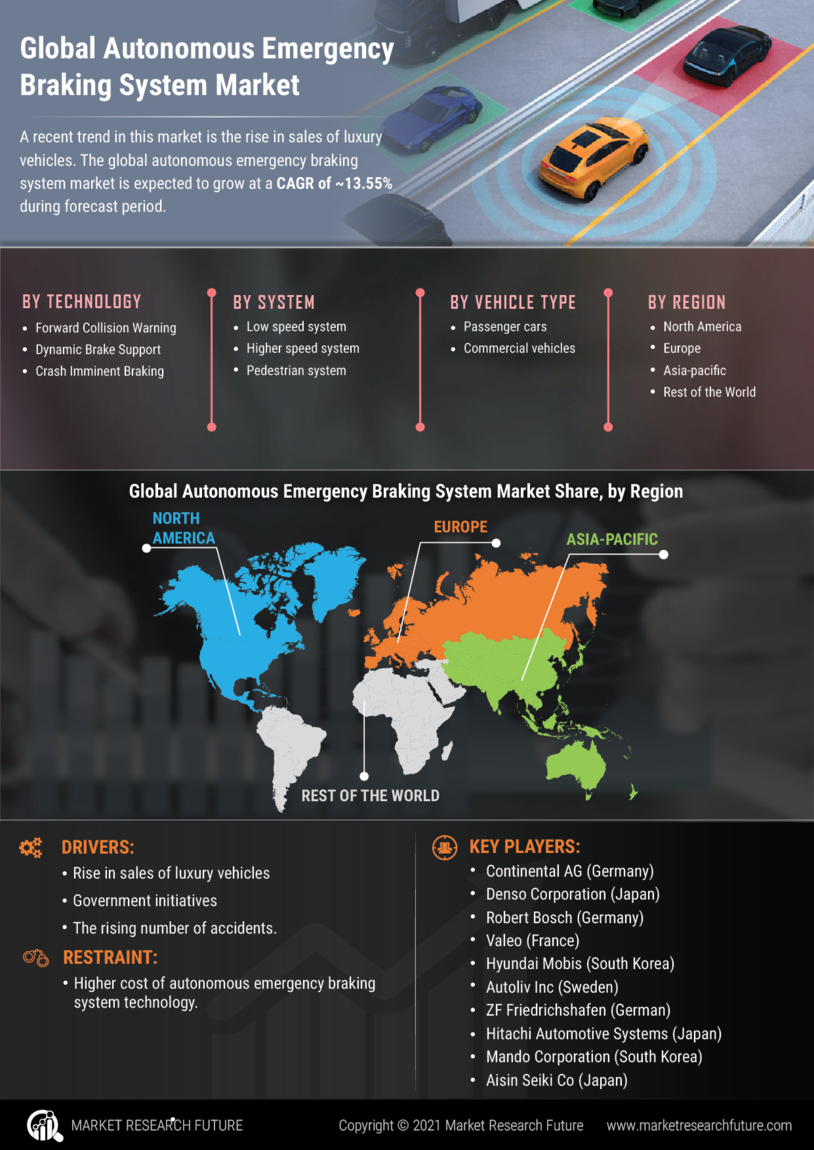Investment in Research and Development
Investment in research and development is a crucial driver for the Autonomous Emergency Braking System Market. As competition intensifies among automotive manufacturers, there is a concerted effort to innovate and improve safety technologies. Companies are allocating significant resources to R&D initiatives aimed at enhancing the functionality and reliability of autonomous emergency braking systems. Recent reports suggest that R&D spending in the automotive sector is expected to reach USD 100 billion by 2027, with a substantial portion directed towards safety technologies. This focus on innovation is likely to yield advancements that will further propel the Autonomous Emergency Braking System Market, as manufacturers strive to meet consumer expectations and regulatory demands.
Regulatory Influence on Safety Standards
Regulatory bodies are playing a pivotal role in shaping the Autonomous Emergency Braking System Market. Governments worldwide are implementing stringent safety regulations that mandate the inclusion of advanced safety features in new vehicles. For instance, the European Union has proposed regulations that require all new vehicles to be equipped with autonomous emergency braking systems by 2024. This regulatory push is expected to significantly increase the adoption of these systems, as manufacturers seek compliance to avoid penalties. The anticipated rise in regulatory requirements is likely to propel the Autonomous Emergency Braking System Market forward, as automakers invest in technology to meet these standards.
Consumer Demand for Enhanced Safety Features
There is a growing consumer demand for enhanced safety features in vehicles, which is significantly impacting the Autonomous Emergency Braking System Market. As awareness of road safety increases, consumers are actively seeking vehicles equipped with advanced safety technologies. Market Research Future indicates that approximately 70% of consumers consider safety features, including autonomous emergency braking, as a critical factor in their purchasing decisions. This shift in consumer preferences is prompting automakers to prioritize the integration of these systems into their vehicles. Consequently, the rising demand for safety features is expected to drive substantial growth in the Autonomous Emergency Braking System Market.
Technological Advancements in Sensor Technology
The Autonomous Emergency Braking System Market is experiencing a surge in technological advancements, particularly in sensor technology. Enhanced sensors, such as LiDAR and radar, are becoming increasingly sophisticated, allowing for improved detection of obstacles and pedestrians. This evolution in sensor capabilities is crucial, as it directly influences the effectiveness of autonomous emergency braking systems. According to recent data, the integration of advanced sensors is projected to increase the accuracy of these systems by over 30% by 2026. As manufacturers strive to enhance vehicle safety features, the demand for cutting-edge sensor technology is likely to drive growth in the Autonomous Emergency Braking System Market.
Integration with Advanced Driver Assistance Systems (ADAS)
The integration of Autonomous Emergency Braking Systems with Advanced Driver Assistance Systems (ADAS) is emerging as a key driver in the Autonomous Emergency Braking System Market. As vehicles become more automated, the synergy between various safety technologies enhances overall vehicle performance and safety. The combination of autonomous emergency braking with other ADAS features, such as adaptive cruise control and lane-keeping assistance, creates a comprehensive safety net for drivers. This integration is projected to increase the market share of autonomous emergency braking systems, as consumers are more inclined to purchase vehicles that offer a full suite of safety technologies. The trend towards integrated systems is likely to bolster the growth of the Autonomous Emergency Braking System Market.


















Leave a Comment